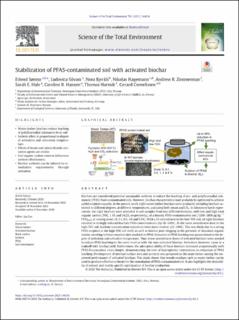| dc.description.abstract | Biochars are considered potential sustainable sorbents to reduce the leaching of per- and polyfluoroalkyl substances (PFAS) fromcontaminated soils. However, biochar characteristicsmust probably be optimized to achieve useful sorption capacity. In the presentwork, eightwaste timber biochars were produced, including biochars activated to different degrees, at different temperatures, and using both steamand CO2. In laboratory batch experiments, the eight biochars were amended to soil samples from two different horizons, with low and high total organic carbon (TOC, 1.6% and 34.2%, respectively), of a heavily PFAS-contaminated soil (1200–3800 μg kg−1 PFAStot), at varying doses (0, 0.1, 0.5, 1.0 and 5.0%).With a 5% amendment to the low-TOC soil, all eight biochars resulted in strongly reduced leachate PFAS concentrations (by 98–100%). At the same amendment dose in the high-TOC soil, leachate concentration reductions were more modest (23–100%). This was likely due to a strong PFAS-sorption to the high-TOC soil itself, as well as biochar pore clogging in the presence of abundant organic matter, resulting in fewer sorption sites available to PFAS. Reduction in PFAS leachingwas proportional to the degree of activation and activation temperature. Thus, lower amendment doses of activated biochars were needed to reduce PFAS leaching to the same level as with the non-activated biochar. Activation however, came at a tradeoff with biochar yield. Furthermore, the adsorption ability of these biochars increased proportionally with PFAS-fluorocarbon chain length, demonstrating the role of hydrophobic interactions in reduction of PFAS leaching. Development of internal surface area and porosity was proposed as the main factor causing the improved performance of activated biochars. This study shows that woody residues such as waste timber can be used to produce effective sorbents for the remediation of PFAS-contaminated soil. It also highlights the desirability of sorbate and matrix-specific optimization of biochar production. | |
